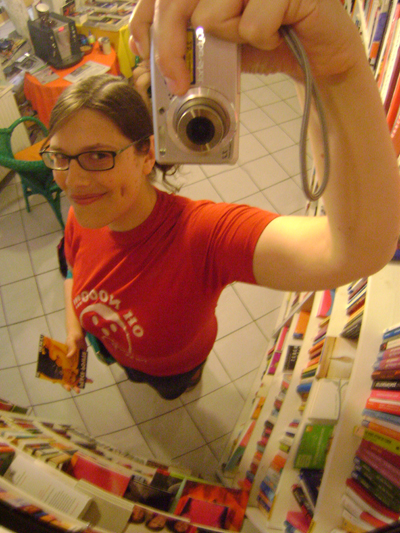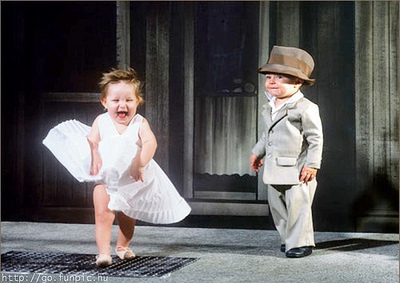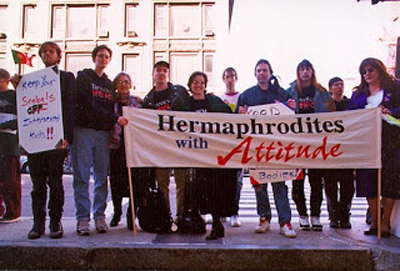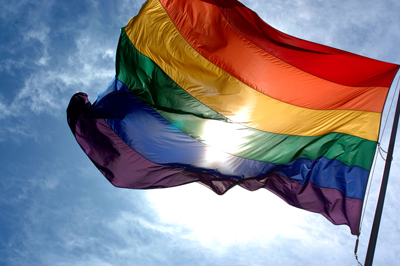Hey there, Autostraddlers. I’m Claudia, and I’m intersex.

I mean, I’m lots of things. For example, I’m . . .
- a graduate student in the sciences in NYC
- a feminist with riot-grrrly-type tendencies
- a gay lady with an amazing girlfriend and some of the best friends, both queer and straight, that I could ever hope for
- a chronically late sleeper & recovering procrastinator
- a not-recovering peanut butter m&m’s addict (THEY ARE PERFECT AND WE’RE IN LOVE)
But yeah, I’m also intersex. And this is why I’m really here.
Intersex is generally thought of as a medical condition—a rare and kind of weird thing that sometimes happens to kids and needs to be fixed. I feel like the cultural consciousness around intersex is the image of an androgynous-y looking person with both a penis and a vulva; like a man and a woman smashed together, who is maybe “really” male or female, or maybe both, or maybe something else entirely.
This image isn’t accurate, although it took me more than a decade to really understand and embrace that. Intersex, first and foremost, is about bodies—a biological way of being. When most individuals are born, the doctor or the doula or the flustered taxi cab driver shouts out, “It’s a boy!” or, “It’s a girl!” The person shouting figures out whether this new, tiny human is a boy or a girl by inventorying the set of physical traits they have. Although doctors typically check only external genitalia to assign sex, these traits also include internal sex organs, chromosomes, and hormone types and levels. If a child has all the “boy forms” of these traits, he’s a boy. If the child has all the “girl forms” of these traits, she’s a girl. Intersex people are born with a mix of sex characteristics – some traditionally considered male, and some considered female – in the same body. For example, I have a vagina and later developed breasts and hips, but I also have XY chromosomes, and had testes at birth. I’ve got some “male” traits and some “female” traits in the same body, so it’s not so easy to clearly assign me “male” or “female.” My own body is just one example; intersex isn’t a single category, and there are many different variations of intersex and, within each variation, a lot of diversity. Not all male or female bodies look and function the same, you know? Knowing that I’m intersex alone doesn’t really tell you much about me or my body.

via gather.com
Understanding what intersex means also helps with understanding what it doesn’t mean. Our bodies are natural and normal and healthy; while some health problems are associated with some forms of intersex, simply being intersex isn’t a health problem in and of itself. Females typically have ovaries, but the fact that some women can get ovarian cancer doesn’t mean being female is a disease, right? Further, intersex people – biologically speaking – are not hermaphrodites. Hermaphrodites are living things that, at the same time or at different points in their life cycle, have complete and fully functioning sets of “male” and “female” sex organs – external and internal. Humans don’t qualify under this definition, with hermaphroditic species represented mostly by plants, fish, mollusks and other little beasties. “Hermaphrodite” is a dated term that physicians used to apply to people with atypical sex anatomy, and while it is widely considered offensive today, some intersex people have reclaimed it and use it as an inclusive term (e.g., “Give me a herm hug!”) or an identity label. This also means that the popular conception of a hermaphrodite as someone with both a penis and a vagina isn’t biologically accurate. While external genitals may look atypical in some forms of intersex, this is not the case for others. It totally depends. Intersex is definitely about bodies, but it’s not really about genitals.

via knowyourmeme.com
Intersex has long been considered to be a controversial subject, and as I’ve grown to accept my intersex, it’s become harder and harder to understand why. It really isn’t so revolutionary to accept that there’s variation in what people’s bodies look like and how they function. Like, there’s not only brown eyes and blue eyes; there are dark brown eyes and light brown eyes and medium brown eyes and deep deep blue eyes and crystal blue eyes that seem to stare right through you and green and hazel and violet and violet with green flecks in it and blue with gold flecks in it and so many other colors you’d have to catalog them like paint swatches. We’re comfortable with the fact that there aren’t just two heights, or two weights, or two skin colors that people come in.
Why should sex be any different?

via joystory.blogspot.com
This concept – that sex isn’t binary, that there are many ways biological sex can present itself – is a really fucking scary concept for a lot of people. I think it’s because there’s this idea out there that based on the body parts that a person has, their sex, gender, and sexual orientation are all inherently linked in one of two pre-determined sets. A child assigned female at birth is instantly assumed to be of female gender. She’ll feel like a girl, she’ll play with dolls dressed up in pink, she’ll act like a lady, she’ll wear skirts and lipstick, she’ll be kind and nurturing. It’s also generally assumed that she’ll be attracted to boys, and have sex with boys, especially the ever-hallowed penis-in-the-vagina kind of heterosexual intercourse, amirite? (Cue choir of angels.)

via favim.com
But what do you do when confronted with a person whose body isn’t easily categorized as male or female? What would their gender be? Maybe they won’t feel like a boy or a girl and will play with GI Joes dressed up in pink, and act like a lady except when they won’t, and they’ll dress in clothing combinations that scare the kids. Maybe they’ll like just girls or just boys or both or other disturbing little snowflakes like themselves, and who KNOWS what will happen if they reproduce.
Maybe it’s time to freak the fuck out.
In short, unlike typical girls and boys, there are no guidelines telling society how intersex people are supposed to be treated. Intersex bodies create social panic. Our physical traits might not really be so scary, but the implications of accepting our bodies go pretty quickly from what-does-this-mean to what-the-hell-am-I-supposed-to-do-NOW?! Biological sex is one of the most fundamental ways human beings identify and understand each other; if our idea of biological sex is wrong, what else could be wrong? It’s too much to handle.

via en.wikipedia.org
The seemingly obvious solution for a long time has been to just try and “fix” us. We’re really just “normal” boys and girls with medical conditions. Treat the conditions – remove and alter what you can (e.g., genitals, internal sex organs, hormones) and try to forget what you can’t (e.g. chromosomes).
One of the most common “treatments” is genital surgery. Some intersex kids have genitals that are not typically male or female and are sometimes considered “ambiguous.” (I hate this term. Our genitals don’t, like, morph their shape every so often or something. Our bodies aren’t “in between” male and female bodies. They exist in their own right.) The clitoris and the penis develop from the same tissue in the body, so some individuals have what can be considered an enlarged clitoris or a small penis. Enlarged clitoris = too masculine for girls, and small penis = not a real man, so clinicians and parents usually opt to assign these children female and make this structure smaller (or, a few decades ago, remove it altogether) to look “normal.” Never mind that these surgeries are for cosmetic purposes and do not track health. Never mind that the children are almost always very young, and cannot consent to these procedures. Never mind that these kids, when they grow up, might not feel sexual sensation to some degree/at all under the scar tissue, might not ever know what an orgasm feels like. Never mind that the surgeries are irreversible, these kids have to live with the results of those surgeries for the rest of their lives.
There are many other treatments to “correct” the many ways that intersex bodies make other people uncomfortable. Doctors try to surgically move the urethra to the tip of the penis when it’s located elsewhere, or less commonly, surgically change an enlarged clitoris/small penis into a bigger penis. Multiple procedures are often necessary, and they result in a lot of scar tissue. Vaginal canals deemed not long enough for normal, heterosexual sex are reconstructed, although they might not self-lubricate or can close up or prolapse. Barring surgery, these vaginal canals can also be “dilated,” or regularly stretched with medical dildos for months or years. Internal sex organs are often removed because clincians warn there’s a chance they can become cancerous if left alone. This practice isn’t very logical, though; after all, doctors don’t remove typical girls’ ovaries or boys’ prostates at birth because these kids might develop ovarian/prostate cancer someday. Removing internal sex organs can make once-fertile individuals non-reproductive, and unable to produce hormones important for development and bone health. My testes were removed a few months after birth, and now I take a pill every day to replace the hormones my body could make on its own. I am privileged enough to have health insurance right now, but buying those pills feels yucky on principle, and it upsets me that I have to take them at all. While I elect to take my pills most days, doctors might put children on hormone replacement therapy from a young age to develop like a typical boy or girl. The results are sometimes irreversible.
There’s so much that intersex people have to live through, and heal from.

via guardian.co.uk
For a long time, I bought into the medical model of intersex, that I was some kid of girl-thing-person-whatever, and that it was the doctors’ jobs to make me normal—to erase the parts of me that were too strange, too much, and help me be this real girl that was buried somewhere inside of me. I was born in the mid-80s, when the internet wasn’t around yet, and I’d never heard anyone describe intersex as something other than a medical condition. It wasn’t until college that I began exploring intersex, on my now laughably bulky desktop in my dorm room when my roommate wasn’t there. I began to learn about my body and see other perspectives. There were other intersex people, like me, who seemed to think that intersex wasn’t this bad thing that needed to be fixed and erased. They said that what was done to their bodies was wrong, that it was done without their consent, that their parents and their doctors shouldn’t be able to make choices about what’s done to their body when it doesn’t track health. They asserted that doctors shouldn’t be involved at all: if our natural bodies are healthy, they reasoned, then why go to the doctor to “fix” it? We’re not sick—what’s to fix?
What needs to be fixed is the way we view intersex in our society, and the cosmetic medical procedures we’re subjected to without consent. Intersex activists started mobilizing in the early-mid 90’s. The first public protest by intersex people was held in 1996 when I was just ten, two years after I learned that I didn’t have a uterus and wouldn’t get my period, and three years before I’d hear the word intersex for the first time. Since then, many intersex activists have been working to raise awareness that intersex exists and that we’re just normal people, even if our bodies are less common.

via intersexualite.de
Today, I know that the medical model isn’t accurate, and I’ve been working to do something about it. I’m the author of the blog Full Frontal Activism: Intersex and Awesome, the co-founder and co-coordinator of NYC’s annual Intersex Awareness Day events, and the Associate Director of the U.S. chapter of Organization Intersex International (OII), the world’s largest global advocacy group for intersex issues. (The U.S. webpage is under construction right now, so feel free to check out OII Australia’s fantastic website instead.)
As a gay lady, I’ve also been doing more thinking about the overlap of intersex issues with all things queer, like the heterosexism inherent in performing major surgical procedures to ensure that a vagina can accomodate a penis, or constructing a “normal clitoris” that won’t potentially freak out a male partner. It’s also becoming increasingly common to screen fetuses for certain kinds of intersex, like congenital adrenal hyperplasia (CAH) [1]. Most CAH individuals are generally assigned and raised as female, but since they have relatively higher testosterone levels, being queer is seen as a secondary effect of CAH [2]. CAH → gay/queer. So parents are electing to have blood samples taken in utero to see if their kid will have CAH, at which point they can decide whether they want to terminate the pregnancy. All of this stuff is queerphobic, as it allows no space for these kids to make choices about what they want their body to look and function like based on who they’re attracted to, and what kinds of sex they want to have someday. There are many reasons why parents and doctors may want to have their intersex child surgically altered, and in some cases, queerphobia may unfortunately be at the top of the list.

via osisa.org
Intersex is now being included in the LGBT acronym, in adding the “I.” Not all intersex people are comfortable with this, and many of the same arguments that were used before including trans* individuals are now used for intersex: that intersex isn’t a sexual orientation or a gender identity. That not all intersex people feel queer in L, G, B, or other ways, and don’t want to be affiliated with the queer community. Not all intersex people want to publicly acknowledge their intersex, or don’t identify as intersex, because intersex people are already normal just as we are. More intersex activists are now opting for intersex inclusion in LGBTI, however, because our broad goals are in line with those of other queer movements: treat us as equals and accept our autonomy, regardless of our sex and gender identities and what we choose to do with our bodies. Look at us, know that we’re real and we’re visible if you open your eyes and your mind, and know in your heart that what’s happening to us is bullshit.
Let us choose what to do with our bodies and our selves.
I am really excited to be talking about intersex issues on Autostraddle. While I want to discuss issues broadly related to intersex, I really want to focus on issues affecting queer intersex ladies. How our bodies influence our understanding of our sexual orientations. How being intersex adds another layer of coming out to potential sex and relationship partners. How being queer takes on a new dimension when other people realize you’re queer AND intersex. How to be supportive of intersex sex partners, who might have physical and emotional scars from being shuttled through the medical system.
I also want to share some of my history – my personal stories – and create some dialogue about intersex issues you, dear readers, want to have.
Like I said, I’m Claudia, and I’m intersex.
Thanks for letting me share this with you. It’s really great to meet you. <3
1. Karkazis, 2008 – Fixing Sex: Intersex, Medical Authority, and Lived Experience
2. Feder, 2011 – Where Medicine and Homophobia Meet: The Case of Prenatal Dexamethosone







